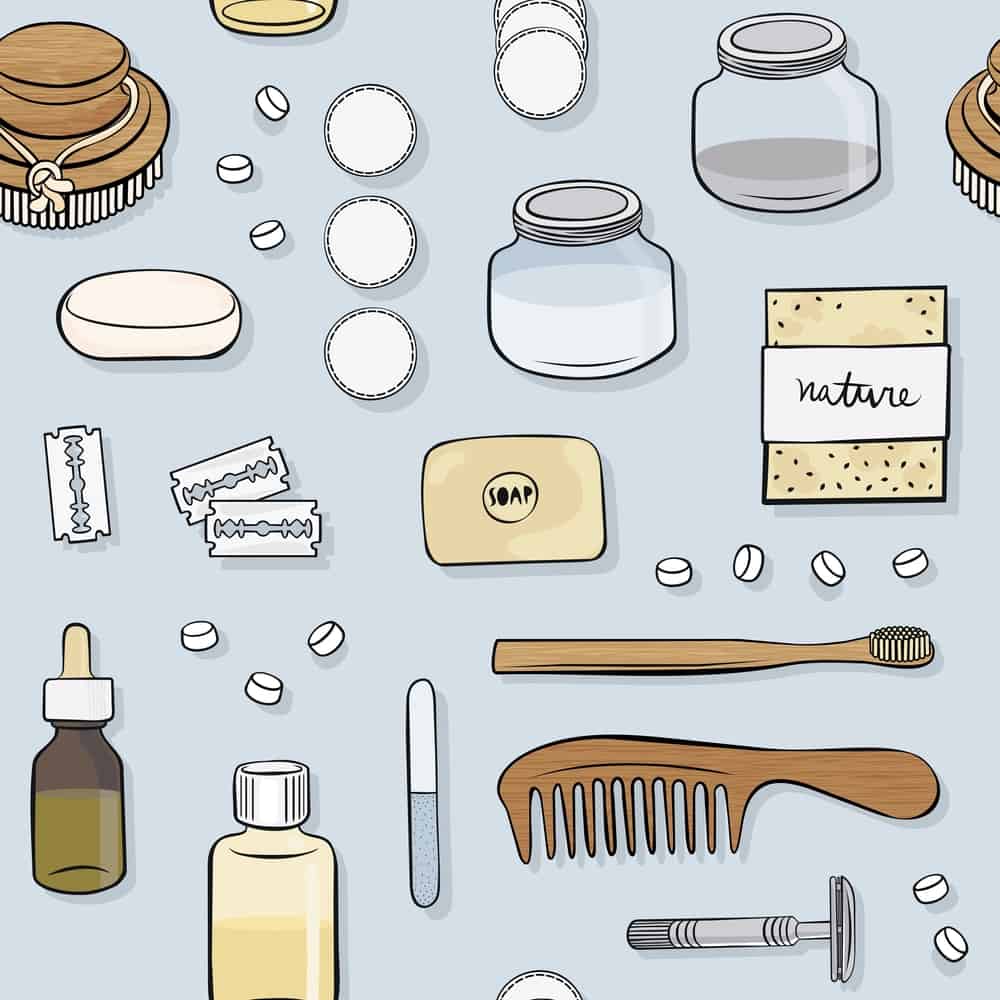In my earliest days of zero-waste, I was convinced I had to replace everything with sustainable solutions immediately.
Luckily I fell deep down the rabbit hole and quickly realized how counterproductive that would have been.
I remember feeling embarrassed that I thought this was how to become zero-waste!
Zero-Waste living has gained significant awareness and popularity over the past few years thanks to social media.
While you might be thinking that you could donate everything, get a starter kit, and be on your merry waste-free way – and you could – but from my own experience, there is something indescribably satisfying about using up the last of something and being able to finally replace it with that sustainable alternative you’ve been eyeing!
I’ll even let you in on a secret – this will save you time and money!
“BUT SUSTAINABLE PRODUCTS ARE MORE EXPENSIVE”
The cost of switching to a lower waste lifestyle seems intimidating, and in some cases, it can be, but here are a few important things to keep in mind…
- Products are built to last
- They often are made from natural, organic ingredients!
- No toxic chemicals
- Biodegradable packaging
- Sustainably and ethically produced
That box of saran wrap for 99 cents may seem cheaper than those 20$ reusable beeswax wraps, but how many times this year is the roll going to stick together, get knotted, thrown away and replaced “because it was 99 cents?”
Although upfront, it can seem a much more expensive lifestyle, and yes, if you want the most glamorous version, you will most definitely pay a glamorous fee. Still, luckily for those of us drowning in debt, there are resources available that make sustainability affordable.
For me, this lifestyle has actually been more affordable and a great way to save money and pay off debts!
REALITY OF ZERO-WASTE EXPENSES
A huge misconception is that you have to buy every alternative! Many zero-wasters create their own products.
DIY Money Saving Bonuses:
- You know exactly what is going into your products
- You can shop in bulk and save money and plastic!
- The fun of experimenting
Zero-Waste is not always picture perfect! Yes, that minimalist and natural aesthetic is satisfying, but let’s not hide the less appealing truths behind our cabinet doors! All parts of zero-waste are beautiful!
A huge part of zero-waste living is repurposing many of the things we’d otherwise throw away.
Every item you repurpose is not only one less piece of trash in the landfills, but it’s also one (or many) items you do not need to buy.
Find multi-purpose products! One of my favorite products is Dr. Bronner’s, because of its universal use.
I can pre-mix my cleaning supplies with the provided ratios in old spray bottles and containers, and one container lasts me weeks.
I can’t lie to you, though, one of my favorite parts of this journey has been finding a product I can rave about! While they may seem more costly upfront, these products are often built to last and can actually save money! But let’s not forget what you are buying when shopping for zero-waste:
- A more naturally-made alternative
- A sustainably packaged product
- An environmentally friendly product
- A product you’ll seldom have to replace
So think of it as an investment, in your journey, in yourself, and in the planet! I’ve put together some product comparisons of a few of my favorite swaps to demonstrate how making these changes can save you money in time.
But please keep in mind, a considerable part of zero-waste is refusing.

THE SIMPLE BARE-NECESSITIES
A few of my must-haves that is integrated in as needed are affordable for any budget!
- Toothbrush and Toothpaste – throw this bamboo toothbrush into the compost when it’s time for a new one, and restock up on one of these toothpastes at your local refill station!
- Beeswax Wraps – say good-bye to aluminum foil, saran wrap, and Ziplocs! These wraps are great for sandwiches, leftovers, fish and produce!
- Avo-Saver– if you’re an avocado lover, you need this! No more brown spots and Ziploc bags! Keep it fresh and bag free!
- K-cup Coffee Refill -skip the Starbucks and expensive, wasteful k-cups, this attachment is refillable with your own zero-waste coffee beans!
- Loose-Leaf Tea Infuser – avoid individually wrapped tea bags, and use loose herbs in an infuser like this one to cut back on waste!
- Dishwasher Detergent – it’s the twenty-first century and for dishwasher lovers, there are more sustainable options than pods! If your budget doesn’t allow for Dr. Bronner’s, or eco-friendly pods, this powder detergent from Target is affordable and plastic-free!
- Un-Paper Towels – Paper products can just about double my grocery bill, but these un-paper towels are washable and more absorbent! Or you can make your own.
- Vinegar – cleaning products are both expensive and many times toxic. To save on wasteful wipes and spray bottles, buy vinegar in bulk and use it as an all-purpose cleaner! Affordable and effective!
- Menstrual Cup – sustainable feminine products are a must, ladies! Quality reusable products are comparably priced to disposable ones, and are healthier too!
PLASTIC V. SUSTAINABLE: WHAT ONE REALLY COSTS MORE
- Over the length of time one piece of well taken care of beeswax wraps would last you, you would spend the same amount or more on single-use aluminum foil.
- Over the length of time a menstrual cup can be used (ten years), you may spend 600 dollars or more on tampons.
- This safety razor from less than costs less than 25$, and its replaceable blades cost under 3$. The average blade lasts about 7 shaves, if well taken care of. Disposable razors, some only usable once or twice, may cost up to 35$ a piece in that length of time.
- The average household spends 50$ a month on cleaning supplies according to various statistical websites, and a single 32 oz bottle of Dr. Bronner’s lasts me about a month, or longer, and can be used for all of my obsessive cleaning needs.
With a little bit of digging, zero-waste is often a great way to save money throughout your journey.
Large corporations that produce cheaper products, use plastic packaging, and more inexpensive ingredients often make more money over time as you constantly need to rebuy their products.
That’s why they are not made to last! If everyone only needed to buy their product one time, their vast corporations would not survive.
TIPS FOR SUSTAINABLE SHOPAHOLIC BUDGETS
I remember a time when shopping was my favorite hobby.
I wish it weren’t true, but I still love spending money! Nowadays, I am better informed, and so I make wiser purchases.
There are many hacks that shopaholics can take to feed their addiction while still reducing or even offsetting their carbon footprint.
Buying zero waste doesn’t always mean you have to buy, it discourages it as we’ve learned, but when it does…
- Know Who You’re Supporting – When researching a new appliance, you look at the product reviews, but why not the companies? Do a quick search and see if that vacuum is made by a company that donates to environmental agencies, or if that perfume is cruelty-free! Some companies take greater initiatives than others, and you may value others’ efforts more than others!
- One of my favorite affordable active-wear companies as Adidas, and they just designed this fabric made from recycled materials!
- Best Buy offers a financing option for appliance and technology purchases, and they are constantly trying to reduce their carbon emissions more each year!
- Take advantage of Thrifting – Thrifting is great for all sorts of finds! Jackets, decor, furniture, books – everything honestly! If you’re a crafter, thrift stores have lots of amazing items to flip. If thrifting itself wasn’t rad enough for you, the flip sure will be! Another man’s trash truly is another’s treasure. You can even find items brand new, still with tags at thrift stores for a fraction of the original price.
Give your reading glasses a quick break and check out these great videos for more additional green money-saving tips!
Check out this one for Insider Info or vegan and waste-free recipes for tight budgets!
NON-PLASTIC TIPS TO SAVE WHILE LIVING ZERO WASTE
Depending on where you live, there are various store options – include three links to how to find local zero waste/organic health food stores by location
- We still need to eat Grocery Shopping, and grocery shopping for zero-waste can be a learning experience for years. A few quick tips:
- Take advantage of your local farmer’s markets
- Use electronic coupons
- Choose glass and cardboard over plastic
- Find a zero-waste or bulk store near you, check out this website to see a list of zero-waste or bulk stores closest to you
- Give up fast food, or bring your own to go containers when dining out!
- Remember your reusable bags – or make your own!
- Check Clearance – many stores offer a clearance section of food nearing their sell-by date, with 30% or more off the sale price!
- Near-Perfect Produce – check out misfits market, imperfect goods, perfectly imperfect Produce or local Produce stands that may offer discounts for Produce that may be near its shelf life, or just looks a little wonky!
- Leisure Activities – for some reason these days, we think that we can’t do anything without money. There are so many free activities available to us that are environmentally friendly and help get us out and bonding with our environment! Gather some friends and have a picnic, BBQ, hike, or beach day. Put your knowledge to the test and bring sustainable dishware, cutlery, and snacks. Challenge you and your friends to produce no trash throughout the whole venture.
- Save Your Jars – no need to buy expensive Tupperware, your jars from last month’s grocery haul will do the trick! Without those BPAs too! Check out these hacks to effectively remove those sticky labels!
- Learn How To Sew – you’ll have to replace less clothing if you can fix those tiny holes that always seem to show up at the worst possible times. Save money without having to buy new – or at all. Finally reach your goal weight? Take your clothes in yourself and avoid spending hundreds on fast fashion!
FREEWAYS TO REDUCE YOUR CARBON FOOTPRINT
Let us not forget the famous R’s – Refuse, Reduce, Reuse, Recycle!
There are so many amazing ways to reduce your carbon footprint that don’t cost a dime!
When you truly embrace refusing things you don’t need, you’ll notice the trash has been empty for weeks.
Here are a few great ways to lower your carbon footprint without spending a dime:
- E-bills instead of paper bills – change your bills to be sent to you virtually instead of by mail. Avoid unnecessary paper and envelopes for something probably on autopay anyway. Many providers even offer discounts if you switch to paperless billing!
- Opt-out of unnecessary junk mail – stop by your local post office to find out how!
- Cancel magazine subscriptions – in the past I always thought free meant take. When I placed an online order and a free magazine subscription was offered, I always found an excuse to add one of them to my order, even if I never read it every month. Cancelling these will save not only clutter in your house for three years but also on waste in both production and after throwing it away.
- Donate – many things we throw away can be donated. Make your trash another person’s treasure. Sell your clothes or used goods in a consignment shop – they’re even online these days! Don’t forget about good ole fashion yardsales!
- Re-Gift – trust me, I know going through those 20 body lotions takes a long time, but you don’t have to do it alone. Re-Gift products you aren’t or won’t use. I always ask my friends if they want something before I throw it away, too!
- Amazon – Amazon Prime has been a real game-changer the past several years. We are able to get nearly anything at the click of a mouse in as soon as a few hours! As many corporations have made strides toward sustainable actions, Amazon has made efforts as well. Now you can opt-out of additional packaging, arrange for your items to be packaged together with a slightly longer wait, or have many packages delivered on the same day. This saves on unnecessary mailing materials and fossil fuels. Find out how, here!
- Save on electric – Junk mail still lurking around the mailbox? Use fire-safe paper recyclables as kindling for your fire! Avoid using chemicals or unnatural kindling and keep the heat off this winter by burning that old pile of mail you saved for no reason. Be sure to know what cannot be burned!
- Compost – composting is beautiful and has many benefits! It is a way for us to give back to the earth, and keep the earth giving back. You don’t need to have a compost pile or bin – although some are even equipped for kitchen counters! Contact local farms or city officials and see if there is a community compost you can add to – some farms or neighbors may even come pick it up for you!
- Clean up – Clean up – Everybody – Everywhere – take a bag with you on outdoor adventures. Walking your dog? Bring two bags! I know those plastic bags under your sink are multiplying despite those reusable bags in your car… have a bag or reusable glove handy to pick up any trash along your way. Feeling guilty about using plastic? Weave them into something more sturdy and reusable, repurposing the pile that always grows so you can avoid throwing them away for longer.
- Help the Homeless – mail your plastic bag to one of these charities! Where they are crocheted into sleeping mats for the homeless, or download their e-book and crochet some yourself for a sustainable and charitable craft!
- Turn off the AC and Open Those Windows – save on electricity while saving the planet! Reduce your footprint by turning off the AC and opening up the windows. Let the fresh air in, and cool your house the natural way – with that all natural breeze!
In a recently conducted global survey, roughly 80% of those surveyed said they would buy a more sustainable item if it was available, 70% in agreement even if it was more expensive (Bekmagambetova, 2020).
The saddest part is, most everything has a sustainable alternative; people are just unaware of them.
But as you venture on your journey and inspire others to make small lifestyle changes, start a conversation on how many alternatives are available and how they are the more sustainable option and the cheaper one, too!
Zero-Waste doesn’t have to be perfect.
I’m still learning new hacks everyday! But incorporating as many as we can is the ultimate goal; getting as close to zero-waste as possible.
Remember this is a journey, and it will take time.
Take each turn as they approach you, it doesn’t all need to be made or bought today.
So now that you’ve seen these products are available, that these alternatives are more affordable, that so many free ways to make change are possible, what’s stopping you from trying to go Zero-Waste?


